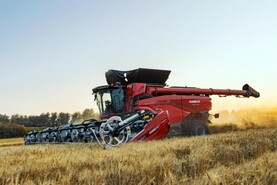I can’t remember the last time a few dry days in a row was forecast, but last weekend, everything came together. The wheat was the most urgent, as it happens. This year, we have three different crops of wheat. The first was for seed sown after beans. This always looked to be the best of the cereal crops, but seed wheat needs to be handled with kid gloves. Round-up cannot be used, as there seems to be a view that it interferes with germination, so an even, weed-free crop is important.
Normally, we hand rogue the seed crops for wild oats. This year, we strimmed the headlands to get rid of any brome. This was followed by a thorough Department of Agriculture field inspection, so when the weather came, we were certainly ready for it. I was nervous that the crop would be either lodged or sprouted after all the rain, but it certainly wasn’t lodged and we have received no word of sprouting from the assembler. After all the effort, while I haven’t the final figures yet, it did a strong 4.5t/ac, despite the very severe spring/early summer drought in our part of the country. The commercial wheat was the opposite. A second wheat sown in poor conditions last autumn, it was badly affected by the winter floods and spring drought. The gaps in an already thin crop were filled by bind weed and it was a textbook lesson in how wheat should not be mucked in. The end result was at best 2.5t/ac, with just one 8x4x4 bale of straw per acre. The wheat after beans did about 2.5 bales/ac. The net difference between the two crops, in profit terms, was enormous.
Meanwhile, the bull phase of my beef life has ended. We sold the last of the in-spec bulls last week. We began tentatively experimenting with bulls after hormones were banned in the late 1980s, and by the time the reference years of 2000 to 2002 were chosen, the system was in full swing. We have stuck with them through thick and thin since then, until the market for 22 month old Irish bull beef apparently disappeared. I must admit, as I compare their dairy-bred replacements, I miss seeing the suckler-bred progeny with their excellent confirmation and productivity.






 This is a subscriber-only article
This is a subscriber-only article









SHARING OPTIONS: